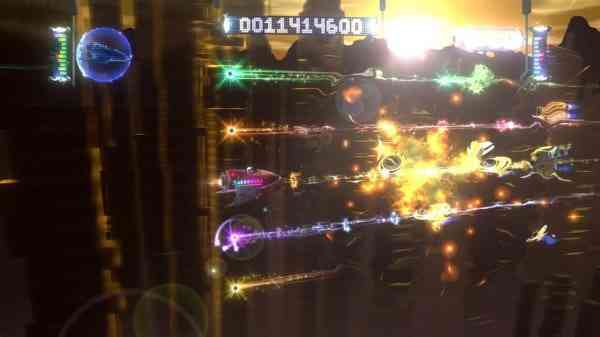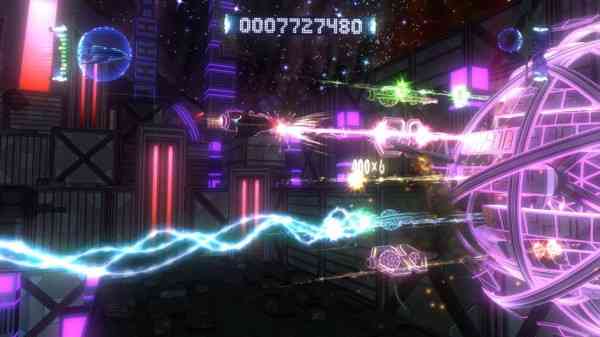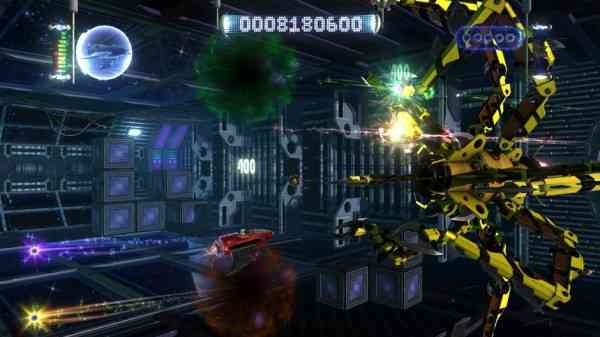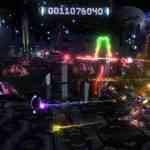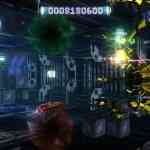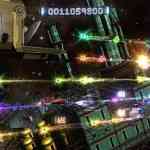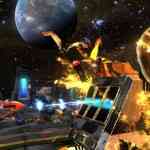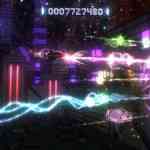If R-Type and Guitar Hero had a baby, my guess is that the result would be something very close to the PSN title Retro/Grade, which is the game that this review is all about. Time to jump into the closets and attics where your old Rock Band and Guitar Hero guitars are gathering dust, as Retro/Grade gives you a reason to use them once again. That being said, I don’t own a guitar for PS3, as all my musical games are on the Xbox 360, so I was only able to play through Retro/Grade with a controller, but it did not feel inferior, as I tried the game back at PAX 2010 with a guitar and I did not feel any different, control wise.
Two years ago when I first tried the game with the guitar, I don’t know if it was the craziness of PAX, the person demoing the game to me not explaining the game properly, or me just not getting it, but I played the game briefly and moved on and forgot about it, as I was not impressed. Here we are two years later and I have been assigned to review it as the EIC of our site did not know my history with it. As I got my review assignment I found that I was somewhat curious to see what has been improved. That being said I was also a little apprehensive of my past experience with it. So I put my bias aside and started up Retro/Grade with a clean slate, hoping to enjoy a shmup/rhythm game (editors note: “shmup” is abbreviation for “Shoot em Up”).
You are Rick Rocket saving the universe. As you begin play Retro/Grade you are find yourself beating the last boss and the credits roll within 10 seconds. Wait…what? As the credits are just about to finish a black hole-like object appears and sucks up everything up, including Rick. All of a sudden there is an explosion that causes everything it just sucked up to get spit back out. At the same time this whole process seems to have reversed the flow of time. This has essentially just undone all the hard work Rick Rocket has done to save the universe, and now you must make sure you properly retrace your actions to prevent any time anomalies.
This does not mean you will be playing all the levels from last to first, but you will actually be playing the game backwards in rewind mode, undoing all your actions and blasters. The campaign gives you six different options of difficulty that range from a simple two lane beginner mode to a hardcore “Xtreme” mode that has five lanes that you will need to constantly traverse. Rick has colored lanes that he can switch between and you are tasked with timing your button presses not only to the rhythm and soundtrack, but also for your blasts coming back to your ship (you know, since you’re undoing all your blaster shots). Since you are playing in reverse, the “enemies” are actually your own bullets coming back to you that you need to catch, or avoid the enemies’ shots coming from the left side of the screen scrolling back towards you. As you switch lanes you will need to catch and avoid shots, and this is easily done by pressing up and down on the controller, or the specific color if you are using a guitar controller. Just like any musical game, you have to time your presses correctly for a better score while trying not to miss.
When you make a mistake, and you will do so when you play the harder difficulties, you actually have the ability to control the flow of time for a short period, essentially being able to undo the mistake you just made by going forward in time. As you rewind, it will resemble how a VCR looks as you rewind in fast motion allowing you to retry the section where you just made a mistake. So yes, you “rewind” to go forward in time; still with me?
As you play you will want to activate your Overthruster to multiply any points you gain for a short while. This is just like Star Power and Overdrive from Rockband and Guitar Hero. You will need to do this if you want to attain the highest score possible, or in this case, the lowest score, because you are playing in reverse and the level starts with a high score and you are trying to get as close to a 0 score as possible. The only problem I had with using this power up is that the screen becomes extremely vibrant and saturated in color, essentially making it more difficult to see bullets and projectiles, making me miss or get hit, thus losing my multiplier.
Once I realized the game is being played in reverse, the first thing I thought of was explained right away. Since you’re playing the last level “first”, wouldn’t the game be “starting” on the hardest or most difficult level and then get easier? Nope, in the first (actual) level, it’s explained that Rick wanted to face the toughest opponent there is, thus making the rest of his journey easier as he went. It is a very small detail but a very clever way to solve the conundrum that I thought would be overlooked immediately.
While the game is beatable in a single sitting as there are only ten levels, the levels are entertaining and vary between enemy types, boss fights, and more to keep you entertained. In my opinion the true fun of the game comes from the Challenge Mode as it has much more variety aside from straight up difficulty jumps. Challenge Mode has you tackling up to 130 different tasks with missions having set goals and stipulations. The first few levels are very easy and you may not be entertained, but later on it becomes very interesting with tasks like mirror mode (un-shooting to the left felt so odd), obtaining a certain multiplier, or not missing a single shot (or note, depending on if you’re playing it like a shooter or a rhythm game) among many others. You can choose which challenges you want to tackle; however, there are certain spots on the map that are locked and you need to beat the level before it opens up allowing you to progress. Doing so will earn you specific extras like remixed tracks, new ships, cheats, and more. There is just enough incentive to stick with Challenge Mode for a good while as you try and gain all of the unlocks.
Retro/Grade has come a long way from two years ago when it did not do to much to impress me. The game plays at 60 frames per second in 1080p and looks fantastic. Environments look sleek and while you will never have time to sit back and enjoy the backgrounds it is easy to see a lot of work has gone into making it look quite sharp. Some of the enemy animations even reminded me of specific enemies from Ikaruga, and seeing the bullet nets coming after me also made me feel like it really was a shmup and not a quirky hybrid rhythm game.
The soundtrack needs to be strong if you are making a rhythm based game, and after my third playthrough of the campaign, there were a few tracks that seemed to be stuck in my head. The unique techno soundtrack completely fits the game and you are essentially “playing” every beat on the harder difficulties, making it much more interesting. With almost an hour of original music, there’s some good stuff here that even surprised me.
With the six difficulty levels to choose from almost anyone can play Retro/Grade based on their skill level. I don’t like to brag, but I’d say I’m very well versed in shmups and rhythm games, but the “Xtreme” difficulty was even near impossible for me, though I’m sure with a guitar it would be much easier since you can ‘skip’ to any lane with a button press rather than having to spam up and down on the regular controller. Heed my warning people, “Xtreme” difficulty is no joke. Challenge Mode will keep you playing for a while after you re-save the universe in the campaign, and if you manage to beat all 130 challenges, the leaderboards is always there to entice you to continue playing more. Given my negative impressions two years ago, I was quite surprised with how much Retro/Grade has been improved and I actually enjoyed playing it. You definitely won’t find anything else like Retro/Grade on PSN, so if you’re a fan of either genre (schmup or rhythm), definitely download the demo and give it a fair shot as you should find that you will be intrigued and drawn to its premise and gameplay elements that you will want buy the full game.
